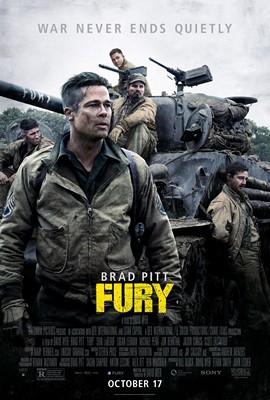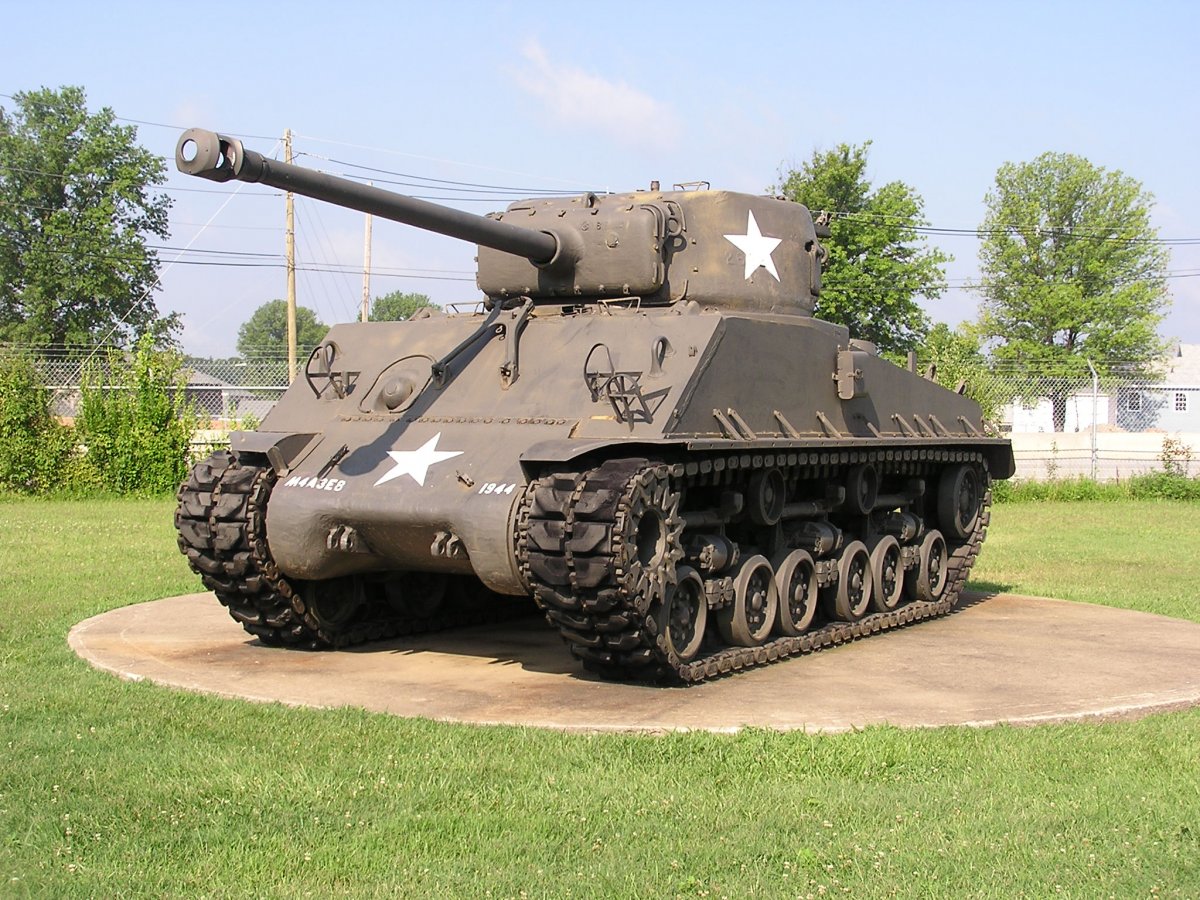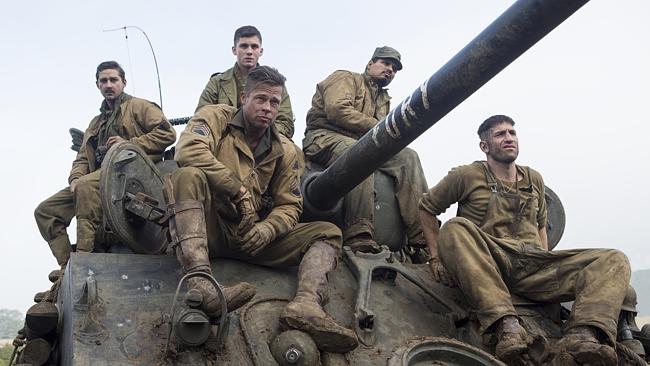Fury is the newest war film from director David Ayer. The movie centers on an M-4 Sherman tank nicknamed “Fury” and its crew of battle-hardened soldiers during the waning days of World War II. Brad Pitt plays Sgt. Don “Wardaddy” Collier—a character that more or less reprises his role from Inglourious Basterds. The rest of the crew is made up of Boyd “Bible” Swan (played by Shia LaBeouf), the bible thumping driver; Trini “Gordo” Garcia, the Spanish-speaking gunner; and Grady “Coon-Ass” Travis, a bestial mechanic with a southern drawl. Their fifth crewmember, the assistant driver, is a young draftee named Norman Ellison (played by Logan Lerman).
 |
The film begins in April 1945, only weeks before Hitler’s suicide. As part of the 2nd Armored Division, the protagonists fight their way through a devastated Germany. The first major combat sequence takes place in an open field, as Collier and his men provide support to infantry in clearing out German machine gun nests. The next battle takes place in a German town, which the Americans succeed in taking after some close-quarters fighting. Disturbing scenes follow: the crew shoots one of their prisoners, sexually brutalizes a number of local women, terrorizes some of the other civilian survivors, and shares an awkward dinner scene with two local women.
The film reaches its climax as the crew of “Fury” defeats a German Tiger tank, losing the other tanks in their platoon in the process. All alone, a mine disables their tank at a crossroads and an SS Battalion soon arrives on the scene. Forced to choose between abandoning their beloved “Fury” or retreating, the crew stays, ambushing the SS column. After running out of ammunition, the crew is killed one by one, save Norman, who crawls under the tank and is rescued the next day by American GIs.
Ayer’s stated goal with the film was to challenge the conventional “good war” narrative. He wanted to demonstrate that “[the war] was just murky. That’s what I wanted to show, that the outcome was wildly positive, but there was this still this incredible price the guys paid, the soldiers paid.” In important ways, he has succeeded in challenging the public conception of the war and the “greatest generation.” But, in striving to make his point, Ayer often takes leave of the actual realities and events of World War II.
To demonstrate the brutalization of the average American soldier, the crew of “Fury” spend most of their time – when not in battle – committing atrocities. The film depicts three of the five members of Collier’s crew engaging in sex with German women with various degrees of coercion. Fraternization between American men and German women is something rarely shown in American war movies (The Dirty Dozen and The Victors are exceptions). But American-German sexual relations were nonetheless widespread, particularly after the German surrender on May 7, 1945. By December, 1945, it was estimated that half of all U.S. servicemen in occupied West Germany had a local girlfriend. However, at the same time, the total number of sexual assaults during the combat phase in Germany has been variously estimated at between 0.008 and 2.3 per 1000 GIs.
 |
| The Sherman M4-A2E8 Tank |
Historian Mary Louise Roberts (in her What Soldiers Do: Sex and the American GI in World War II France) notes that fraternization in Germany during the spring of 1945 was lower than in France, in part due to U.S. Army policies that bivouacked U.S. soldiers away from urban areas and fined anyone caught fraternizing with German civilians—but, of course, some sexual interactions still took place between the population and the U.S. military.
To make his point, the director also expends considerable effort to depict the killings of unarmed German prisoners of war. For instance, Pitt’s character forces the young replacement soldier played by Lerman to execute a German POW on his knees. There is some historical authenticity to this treatment of POWs, although there is really very little historical evidence to document any clear patterns. Historians have offered highly divergent estimations of the number of German POWs shot after being captured: from less than one percent to as high as fifty percent.
 |
| The Tiger I Heavy Tank. Director Ayer used the only operational Tiger I Tank in the World as part of the film. |
Most documented POW shootings involved either retaliation for killings of Allied POWs (such as Malmedy/Chernogne), executions after the liberation of German concentration camps (the Dachau Camp Reprisals), or in the aftermath of particularly fierce combat. But by April, 1945, more than 50,000 German soldiers were surrendering per day and the rates of prisoner shootings seem to have dropped significantly, as comparisons of German and American statistics suggest. Given the film’s setting in April, 1945, the shooting of the prisoner would have been unusual.
By April, 1945, moreover, the United States Army had accumulated tremendous material and manpower superiorities over the Wehrmacht. The unit to which the protagonists in the film belong – the 2nd Armored Division – spent April completing the encirclement of the Ruhr Pocket and then moving on to the Elbe River, which they reached with relatively little resistance. Instead, the film relies on the idea that resistance became stronger and stronger the deeper into Germany the Americans drove. (Statistically, U.S. Forces in Europe averaged 11,967 fatalities a month from June, 1944 to May, 1945. In April, the U.S. Army suffered 10,677 fatalities.)
The defensive stand by a single tank against an entire German battalion in mid-April, 1945 is painfully unrealistic. And the supposedly fierce SS troops engage in some very strange behavior. Instead of using anti-tank weapons like the Panzerfaust (which they can be seen carrying), the first assault against the tank crew is carried out by men who do not appear to be armed at all, except for one who has a knife that Pitt soon plunges into his throat. The SS soldiers do not display any of the tactics that German soldiers by 1945 would have used against a tank. Instead, they function largely as dim-witted extras.
 |
| All Five Soldiers in Fury |
But, while the film plays fast and loose with the realities of the war, the real problem with the film is that it lacks heart. Pitt’s and Lerman’s characters have some depth but the rest of the crew are little more than stale stereotypes. The central development of the film – Lerman’s transformation from naïve innocent to cold-blooded killer – is done awkwardly and unconvincingly. And the frequent moral equivalency made between the German and American soldiers, emphasized by lines like Pitt’s “we’re not here for right or wrong,” renders the characters essentially unapproachable.
The movie challenges the viewers with its dark and gritty vision of the war but its story fails to compel. Ayer’s Fury is an interesting film, but not a good one.
